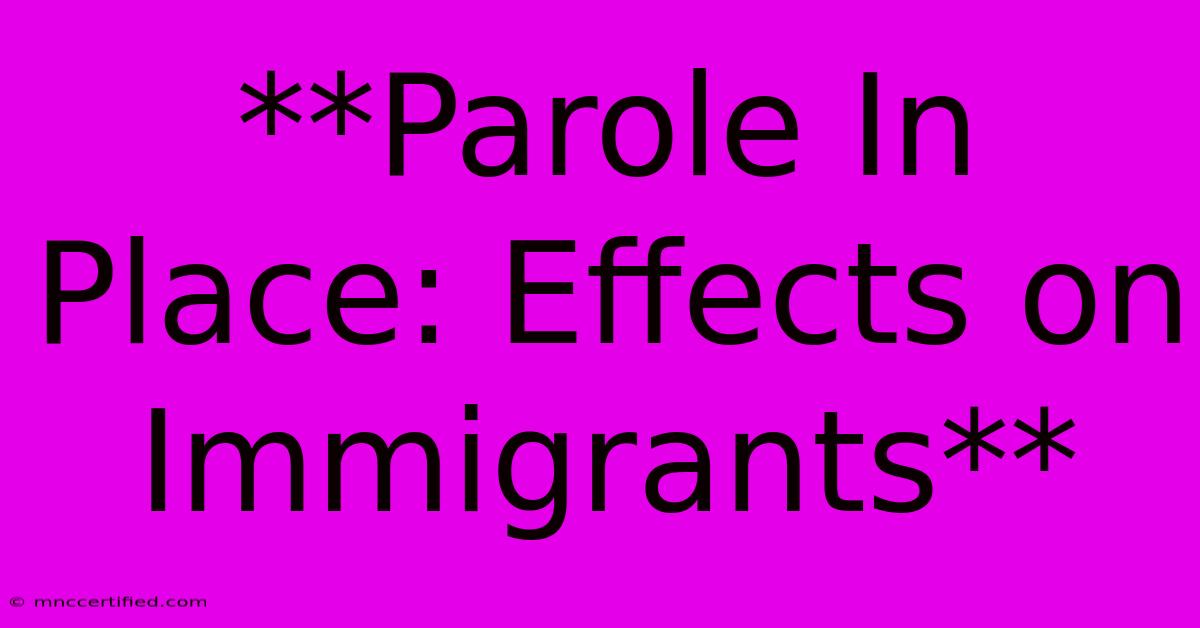**Parole In Place: Effects On Immigrants**

Table of Contents
Parole In Place: A Lifeline or a Loophole for Immigrants?
The United States immigration system is complex and constantly evolving, with policies shifting depending on the political climate. One such policy, Parole In Place (PIP), has become increasingly controversial, particularly in its impact on immigrants. This article will delve into the intricacies of PIP, examining its effects on immigrants and exploring the arguments for and against its use.
Understanding Parole In Place
Parole In Place is a legal mechanism that allows certain individuals to enter or remain in the United States without formal visas. It's a discretionary authority granted by the Department of Homeland Security (DHS) under the Immigration and Nationality Act. Typically, PIP is granted to individuals who meet specific humanitarian or public interest criteria.
Here's how PIP functions:
- Circumventing traditional visa processes: PIP allows individuals to bypass the usual visa application process, providing a faster route to entry or residency.
- Temporary Status: It grants temporary legal status to individuals, enabling them to work and live in the United States.
- Renewal Potential: PIP can be renewed, offering a path to extended stay in the country.
The Case for Parole In Place
Supporters of PIP highlight its potential benefits for immigrants:
- Humanitarian relief: It provides a crucial lifeline to individuals fleeing persecution, violence, or natural disasters in their home countries.
- Family reunification: PIP allows families to stay together, offering stability and support for children and spouses.
- Economic contributions: Immigrants granted PIP often become valuable contributors to the US economy, working in various industries and filling labor gaps.
The Case Against Parole In Place
However, criticisms of PIP abound, focusing on its perceived drawbacks:
- Backdoor immigration: Critics argue that PIP undermines the integrity of the legal immigration system by providing an unauthorized path to entry.
- Exploitation of loopholes: They fear that PIP may be abused by individuals seeking to circumvent immigration laws.
- Resource strain: There are concerns that PIP puts a strain on social services and resources, particularly in areas with large immigrant populations.
PIP and the Immigration Landscape
The use of PIP has seen significant changes in recent years, with different administrations employing it in varying degrees. Notably, the Trump administration restricted its use, citing concerns about its potential for abuse. Conversely, the Biden administration has taken steps to expand its use, particularly for asylum seekers and individuals facing humanitarian crises.
The Future of Parole In Place
The future of PIP remains uncertain. Legal challenges and political debate continue to surround its use. Ultimately, the future of this program will likely depend on the shifting priorities and interpretations of the US immigration system.
Conclusion
Parole In Place presents a complex dilemma in the ongoing discussion about immigration policy. While offering a lifeline for many individuals, it also raises concerns about potential misuse and the integrity of the immigration system. The debate surrounding PIP is likely to persist, as the United States grapples with its ever-evolving immigration landscape.
Key SEO Keywords:
- Parole In Place
- PIP
- Immigration
- Asylum Seekers
- Humanitarian Crisis
- Visa Process
- Department of Homeland Security
- Immigration and Nationality Act
- Immigration Policy
- Legal Immigration
- Backdoor Immigration
- Resource Strain
- Family Reunification
- Economic Contributions
- Trump Administration
- Biden Administration
- Immigration Reform
Note: This article provides an overview of Parole In Place and its impact on immigrants. It is important to note that immigration law is a complex area, and this article should not be considered legal advice. Consult with an immigration attorney for specific guidance.

Thank you for visiting our website wich cover about **Parole In Place: Effects On Immigrants**. We hope the information provided has been useful to you. Feel free to contact us if you have any questions or need further assistance. See you next time and dont miss to bookmark.
Featured Posts
-
Corneal Transplant Cost With Insurance
Nov 09, 2024
-
Twin City Fire Insurance Company Claims
Nov 09, 2024
-
Hk Welcomes Two Debutants Ahead Of Brazil Clash
Nov 09, 2024
-
How To Buy Crypto With Apple Gift Card
Nov 09, 2024
-
A Couple Won The Powerball Investing It
Nov 09, 2024